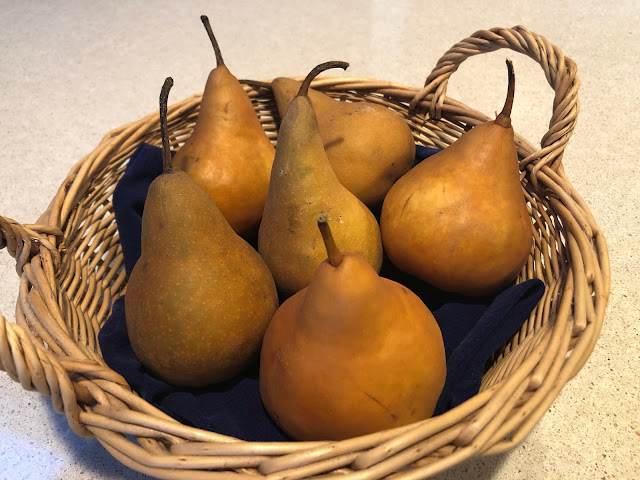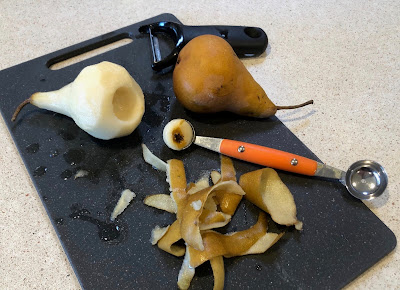
Recipe: Honey-poached pears spiced with cloves
 |
| Bosc pears are perfect for a simple poaching in a honey syrup. (Photos: Kathy Morrison) |
As much as I love to bake with seasonal fruit in fall, sometimes I want to enjoy it as simply prepared as possible. That's especially true with pears, which get crowded out of the fall limelight by apples and all that pumpkin spice whatever.
Pears are picked when still hard, so buy them a few days before you plan to use them. They ripen from the inside out, so test the flesh right near the stem; it should feel just slightly soft. Bartletts ripen fastest, I've found, followed by the d'Anjou variety. Bosc pears are a little drier and grittier, but hold together well, so they're good for a dish like this.
This recipe is adapted from one by the late great James Beard in his "American Cookery." This classic cookbook is the first place I go when I want to find a solid basic recipe. I used local honey instead of the 1-1/2 cups of white sugar the original calls for, and it's still plenty sweet. Adjust the spice to your preference; I considered using nutmeg or cardamom instead of the cloves. Cinnamon would work too, of course.
Serve the pears alone, in their syrup, or with crème fraîche, heavy cream or crème anglaise.
Honey-poached pears
Serves 6

|
Ingredients:
6 ripe but still firm pears, such as Bosc or d'Anjou
2 cups water
1/3 cup honey
1 teaspoon vanilla extract
1/8 to 1/4 teaspoon ground cloves (or nutmeg, cardamom or cinnamon)
Instructions:
Peel the pears, leaving them whole with the stem. Use a melon ball cutter or a paring knife to core the pears from the bottom.
Bring the water, honey, vanilla extract and cloves to a boil in a 4-quart nonstick pot. Add the pears upright. (They may fall over; it's OK.) Reduce heat, cover the pot and cook gently for about 15 minutes, until the pears test done with the tip of a knife. If they've fallen over, roll the pears around so that all sides spend some time cooking in the liquid.
Remove the pot from the heat, and let the pears cool in the liquid with the lid on. Serve warm, at room temperature or chilled, plain or with desired accompaniment.
Comments
0 comments have been posted.Sacramento Digs Gardening to your inbox.
Food in My Back Yard Series
April 1: Don't be fooled by these garden myths
March 25: Fertilizer tips: How to 'feed' your vegetables for healthy growth
March 18: Time to give vegetable seedlings some more space
March 11: Ways to win the fight against weeds
March 4: Potatoes from the garden
Feb. 25: Plant a fruit tree now -- for later
Feb. 18: How to squeeze more food into less space
Feb. 11: When to plant? Consider staggering your transplants
Feb. 4: Starting in seed starting
Sites We Like
Garden Checklist for week of March 30
Your garden doesn’t mind April showers. Get busy now to enjoy those future flowers.
* Get ready to swing into action in the vegetable garden. As nights warm up over 50 degrees, start setting out tomato, pepper and eggplant transplants.
* From seed, plant beans, beets, cantaloupes, carrots, corn, cucumbers, melons, pumpkins, radishes and squash. (Soak beet seeds overnight in water for better germination,)
* Plant onion sets.
* In the flower garden, plant seeds for asters, cosmos, celosia, marigolds, salvia, sunflowers and zinnias.
* Transplant petunias, zinnias, geraniums and other summer bloomers.
* Plant perennials and dahlia tubers for summer bloom.
* Transplant lettuce and cabbage seedlings.
* April is the last chance to plant citrus trees such as dwarf orange, lemon and kumquat. These trees also look good in landscaping and provide fresh fruit in winter.
* Smell orange blossoms? Feed citrus trees with a low dose of balanced fertilizer (such as 10-10-10) during bloom to help set fruit. Keep an eye out for ants.
* Apply slow-release fertilizer to the lawn.